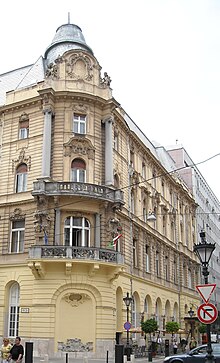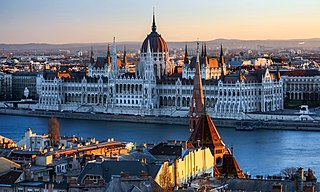
Budapest is the capital and most populous city of Hungary. It is the ninth-largest city in the European Union by population within city limits and the second largest city on the Danube river. The city has an estimated population of 1,752,286 over a land area of about 525 square kilometres. Budapest, which is both a city and municipality, forms the centre of the Budapest metropolitan area, which has an area of 7,626 square kilometres and a population of 3,303,786. It is a primate city, constituting 33% of the population of Hungary.

The Széchenyi Chain Bridge is a chain bridge that spans the River Danube between Buda and Pest, the western and eastern sides of Budapest, the capital of Hungary. Designed by English engineer William Tierney Clark and built by Scottish engineer Adam Clark, it was the first permanent bridge across the Danube in Hungary. It was opened in 1849. It is anchored on the Pest side of the river to Széchenyi Square, adjacent to the Gresham Palace and the Hungarian Academy of Sciences, and on the Buda side to Adam Clark Square, near the Zero Kilometre Stone and the lower end of the Castle Hill Funicular, leading to Buda Castle.

Elisabeth Bridge is the third newest bridge of Budapest, Hungary, connecting Buda and Pest across the River Danube. The bridge is situated at the narrowest part of the Danube in the Budapest area, spanning only 290 m. It is named after Elisabeth of Bavaria, a popular queen and empress of Austria-Hungary, who was assassinated in 1898. Today, her large bronze statue sits by the bridge's Buda side connection in the middle of a small garden.
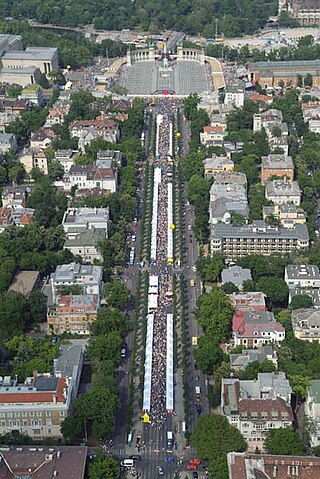
Andrássy Avenue is a boulevard in Budapest, Hungary, dating back to 1872. It links Erzsébet Square with the Városliget. Lined with spectacular Neo-renaissance mansions and townhouses featuring fine facades and interiors, it was recognised as a World Heritage Site in 2002. It is also one of Budapest's main shopping streets, with fine cafes, restaurants, theatres, embassies and luxury boutiques. Among the most noticeable buildings are the State Opera House, the former Ballet School, the Zoltán Kodály Memorial Museum and Archives, the Hungarian University of Fine Arts, and the Ferenc Hopp Museum of East Asian Arts.
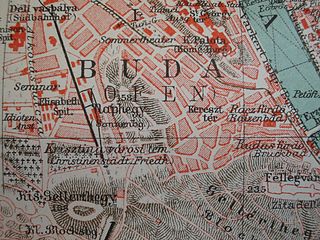
The Tabán usually refers to an area within the 1st district of Budapest, the capital of Hungary. It lies on the Buda side of the Danube, to the south of György Dózsa Square, on the northern side of Elisabeth Bridge and to the east of Naphegy. Several other Hungarian cities and towns also have districts called Tabán.

Gellért Hill is a 235 m (771 ft) high hill overlooking the Danube in Budapest, Hungary. It is located in the 1st and the 11th districts. The hill was named after Saint Gerard who was thrown to death from the hill. The famous Hotel Gellért and the Gellért Baths can be found in Gellért Square at the foot of the hill, next to Liberty Bridge. The Gellért Hill Cave is also located on the hill, facing the hotel and the Danube.

Batthyány Square is a town square in Budapest. It is located on the Buda side of the Danube directly opposite the Hungarian Parliament Building. It is named after Lajos Batthyány, the first Prime Minister of Hungary, and a statue for him was erected in 2008.

Buda Castle, formerly also called the Royal Palace and the Royal Castle, is the historical castle and palace complex of the Hungarian kings in Budapest. First completed in 1265, the Baroque palace that occupies most of the site today was built between 1749 and 1769, severely damaged during the Siege of Budapest in World War II, and rebuilt in a simplified Baroque style during the state communist era. Presently, it houses the Hungarian National Gallery, the Budapest Historical Museum, and the National Széchényi Library.

The Hungarian Parliament Building, also known as the Parliament of Budapest after its location, is the seat of the National Assembly of Hungary, a notable landmark of Hungary, and a popular tourist destination in Budapest. It is situated on Kossuth Square in the Pest side of the city, on the eastern bank of the Danube. It was designed by Hungarian architect Imre Steindl in neo-Gothic style and opened in 1902. It has been the largest building in Hungary since its completion. The architectural style of the Hungarian parliament building was influenced by the gothic Vienna City Hall, and the renaissance elements like the cupola was influenced by the Maria vom Siege church in Vienna.

The Halászbástya or Fisherman's Bastion is one of the best known historical monuments in Budapest, located near the Buda Castle, in the Várkerület. Since 1987, it has been designated a UNESCO World Heritage Site as part of the Várkerület District.

Central Hungary is one of the eight statistical regions in Hungary. It includes Pest County and since 2018 no longer includes Budapest, the capital of the region.

Sashegy is a hill and neighbourhood in Budapest, Hungary. It is a green, upper middle class area in Buda with expensive family homes. Administratively Sashegy is divided between the 11th and the 12th districts of Budapest.
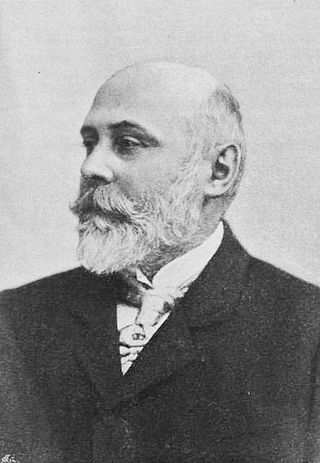
Ödön Lechner was a Hungarian architect, one of the prime representatives of the Hungarian Szecesszió style, which was related to Art Nouveau in the rest of Europe, including the Vienna Secession. He is famous for decorating his buildings with Zsolnay tile patterns inspired by old Magyar and Turkic folk art, which are combined with modern materials such as iron.
Naphegy is a hill and neighbourhood in Budapest, Hungary. It is part of Krisztinaváros and administratively belongs to the 1st District.
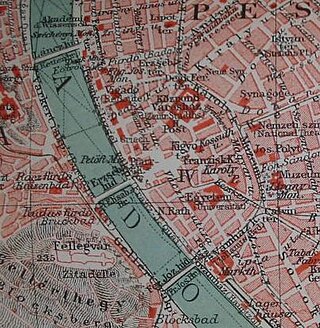
The Danube Promenade is located on the Pest side of Budapest, Hungary. The promenade itself lies on the left bank of the Danube, extending from the Széchenyi Chain Bridge to the Erzsébet Bridge.

The city of Budapest was officially created on 17 November 1873 from a merger of the three neighboring cities of Pest, Buda and Óbuda. Smaller towns on the outskirts of the original city were amalgamated into Greater Budapest in 1950. The origins of Budapest can be traced to Celts who occupied the plains of Hungary in the 4th century BC. The area was later conquered by the Roman Empire, which established the fortress and town of Aquincum on the site of today's Budapest around AD 100. The Romans were expelled in the 5th century by the Huns, who were challenged by various tribes during the next several centuries. The Hungarian conquest of the Carpathian Basin started at the end of the 9th century, and the Kingdom of Hungary was established at the end of the 11th century.
The following is a timeline of the history of the city of Budapest, Hungary.
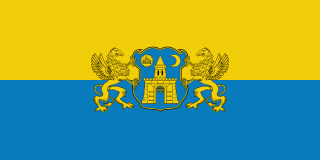
District V is the heart of Budapest and the political, financial, commercial and touristic center of Hungary. The name of the district is Belváros-Lipótváros, which refers to the two historical neighbourhoods that is located in the district; Belváros and Lipótváros . Inner City is the old town of Pest, while Leopold Town was established in the early 19th century, and became the political and financial centre of Hungary in the early 20th century when the Hungarian Parliament was built. The two neighbourhoods were originally the 4th and 5th districts of Budapest until 1950 when the two districts were merged and number IV was given to Újpest.

The Castle Quarter is the part of Buda in Budapest, the capital city of Hungary, that lies within the defensive walls of the Buda Castle complex, corresponding to the medieval royal city of Buda. Located on Várhegy, it is the oldest part of Budapest, having been continously inhabited since 1247. The center of the neigborhood are the streets between the Royal Palace and Matthias Church.

The St. Catherine of Alexandria Church is a Roman Catholic church in the Tabán quarter of Budapest, Hungary. It is the parish church of the Tabán Parish which also comprises parts of Gellért Hill and Naphegy. The church is a listed monument that was built in Central European Baroque style between 1728 and 1777. It was reconstructed several times in the 19th–20th centuries.


